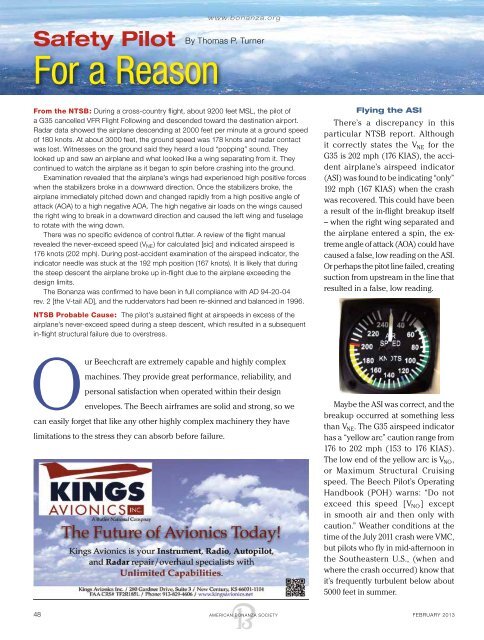ABS Fly-In Savannah, Georgia, May 16-19 See Page 3 - American ...
ABS Fly-In Savannah, Georgia, May 16-19 See Page 3 - American ...
ABS Fly-In Savannah, Georgia, May 16-19 See Page 3 - American ...
You also want an ePaper? Increase the reach of your titles
YUMPU automatically turns print PDFs into web optimized ePapers that Google loves.
Safety PilotFor a Reasonwww.bonanza.orgBy Thomas P. TurnerFrom the NTSB: During a cross-country flight, about 9200 feet MSL, the pilot ofa G35 cancelled VFR Flight Following and descended toward the destination airport.Radar data showed the airplane descending at 2000 feet per minute at a ground speedof 180 knots. At about 3000 feet, the ground speed was 178 knots and radar contactwas lost. Witnesses on the ground said they heard a loud “popping” sound. Theylooked up and saw an airplane and what looked like a wing separating from it. Theycontinued to watch the airplane as it began to spin before crashing into the ground.Examination revealed that the airplane’s wings had experienced high positive forceswhen the stabilizers broke in a downward direction. Once the stabilizers broke, theairplane immediately pitched down and changed rapidly from a high positive angle ofattack (AOA) to a high negative AOA. The high negative air loads on the wings causedthe right wing to break in a downward direction and caused the left wing and fuselageto rotate with the wing down.There was no specific evidence of control flutter. A review of the flight manualrevealed the never-exceed speed (V NE ) for calculated [sic] and indicated airspeed is176 knots (202 mph). During post-accident examination of the airspeed indicator, theindicator needle was stuck at the <strong>19</strong>2 mph position (<strong>16</strong>7 knots). It is likely that duringthe steep descent the airplane broke up in-flight due to the airplane exceeding thedesign limits.The Bonanza was confirmed to have been in full compliance with AD 94-20-04rev. 2 [the V-tail AD], and the ruddervators had been re-skinned and balanced in <strong>19</strong>96.<strong>Fly</strong>ing the ASIThere’s a discrepancy in thisparticular NTSB report. Althoughit correctly states the V NE for theG35 is 202 mph (176 KIAS), the accidentairplane’s airspeed indicator(ASI) was found to be indicating “only”<strong>19</strong>2 mph (<strong>16</strong>7 KIAS) when the crashwas recovered. This could have beena result of the in-flight breakup itself– when the right wing separated andthe airplane entered a spin, the extremeangle of attack (AOA) could havecaused a false, low reading on the ASI.Or perhaps the pitot line failed, creatingsuction from upstream in the line thatresulted in a false, low reading.NTSB Probable Cause: The pilot’s sustained flight at airspeeds in excess of theairplane’s never-exceed speed during a steep descent, which resulted in a subsequentin-flight structural failure due to overstress.Our Beechcraft are extremely capable and highly complexmachines. They provide great performance, reliability, andpersonal satisfaction when operated within their designenvelopes. The Beech airframes are solid and strong, so wecan easily forget that like any other highly complex machinery they havelimitations to the stress they can absorb before failure.<strong>May</strong>be the ASI was correct, and thebreakup occurred at something lessthan V NE . The G35 airspeed indicatorhas a “yellow arc” caution range from176 to 202 mph (153 to 176 KIAS).The low end of the yellow arc is V NO ,or Maximum Structural Cruisingspeed. The Beech Pilot’s OperatingHandbook (POH) warns: “Do notexceed this speed [V NO ] exceptin smooth air and then only withcaution.” Weather conditions at thetime of the July 2011 crash were VMC,but pilots who fly in mid-afternoon inthe Southeastern U.S., (when andwhere the crash occurred) know thatit’s frequently turbulent below about5000 feet in summer.48 AMERICAN BONANZA SOCIETY FEBRUARY 2013

















